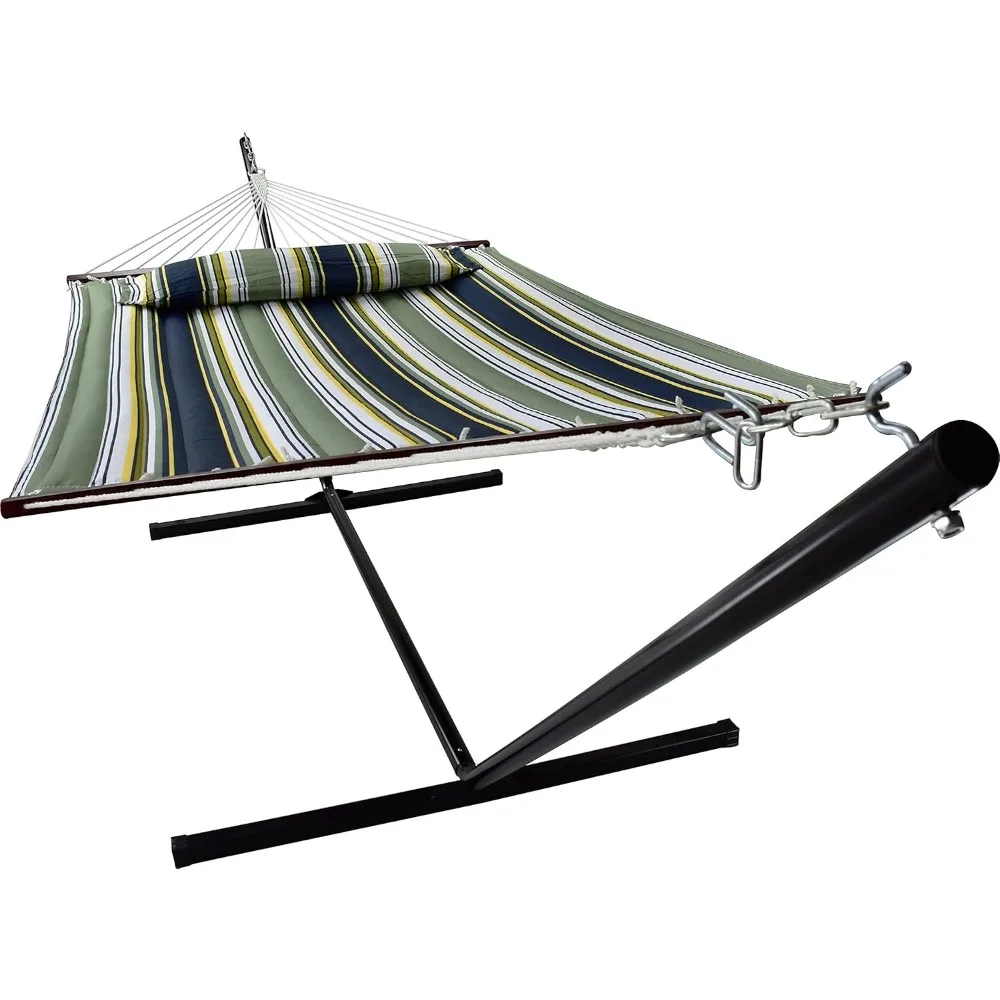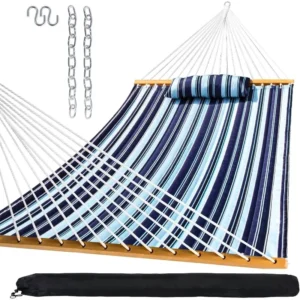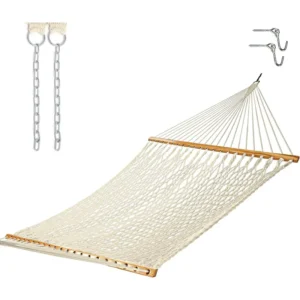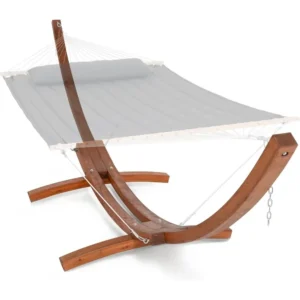Why Fabric Choice Makes or Breaks Your Hammock Experience
When it comes to outdoor relaxation, the fabric of your hammock isn’t just a detail—it’s the foundation of your entire experience. The right material can mean the difference between years of comfortable outdoor lounging and a disappointing purchase that deteriorates after a single season.
Fabric selection directly impacts three critical aspects of your hammock: how comfortable it feels against your skin, how long it will last through environmental challenges, and how well it withstands various weather conditions. At Outside Luxe, we’ve rigorously tested countless hammock materials across different seasons and environmental conditions to understand exactly how they perform.
Think of hammock fabric as the foundation of your outdoor sanctuary. Just as you wouldn’t build a house on shaky ground, you shouldn’t trust your relaxation to inferior materials. The appropriate indoor and outdoor hammock placement works hand-in-hand with your fabric choice to create the perfect relaxation environment.
Throughout this guide, we’ll explore the essential fabric options available today, helping you understand which materials best suit your specific needs, environment, and comfort preferences.
Essential Factors for Selecting the Perfect Outdoor Hammock Fabric
Finding your ideal outdoor hammock starts with understanding what makes each fabric unique. Rather than simply choosing based on appearance, savvy shoppers consider a combination of practical factors that determine long-term satisfaction.
When evaluating hammock fabrics, consider these crucial factors that work together to create your ideal outdoor relaxation experience. The best material for outdoor hammocks varies based on your specific needs and environment.
Comfort Factors: Finding Your Perfect Feel
The comfort of your hammock fabric directly impacts how much you’ll actually use it. Key considerations include:
- Breathability – Crucial for hot climates where air circulation prevents sweating and discomfort
- Texture – Ranges from silky smooth synthetics to textured natural fibers
- Flexibility – Affects how well the hammock conforms to your body
- Seasonal adaptability – Some fabrics feel cool in summer but chilly in spring or fall
Open-weave fabrics typically allow better air circulation but might feel rougher against skin. Tightly woven options offer smoother textures but can trap heat. When considering fabric texture, remember that most high-quality fabric hammock durability factors strike a careful balance between soft feel and long-term resilience.
Durability Considerations: Built to Last
A hammock’s durability determines whether it remains a short-term purchase or a long-term investment:
- Fabric strength – Measured by denier or thread count depending on material
- Tear resistance – Crucial for preventing small nicks from becoming larger holes
- UV degradation – Determines color fastness and fiber integrity in sunny locations
- Weight capacity – Affected by both fabric and construction techniques
While a typical nylon hammock might maintain strength for 3-5 years with proper care, premium materials like certain performance acrylics can last 7-10 years even with regular outdoor exposure. For heavier individuals or those planning to share their hammock, our heavy-duty hammock sets offer enhanced strength ratings with reinforced fabrics.
Weather Resistance: Battling the Elements
How your hammock handles environmental challenges determines where and when you can use it:
- Water resistance – How quickly moisture beads up and rolls off
- Quick-drying properties – Critical for preventing mildew after rain
- Mold/mildew resistance – Particularly important in humid regions
- Temperature adaptability – How comfortable the fabric remains across seasons
Some synthetic fabrics can dry in 1-2 hours of sunshine, while untreated cotton might remain damp for days. Weather resistance becomes particularly important when considering whether it’s okay to leave your hammock outside between uses or during mild weather conditions.
Natural vs. Synthetic: Comparing Hammock Fabric Categories
Before diving into specific materials, understanding the fundamental difference between natural and synthetic hammock fabrics provides essential context.
| Characteristic | Natural Fibers | Synthetic Fibers |
|---|---|---|
| Comfort | Typically softer, more breathable | Can feel slick, less breathable |
| Durability | Moderate; weakens with UV exposure | High; resistant to stretching and UV damage |
| Weather Resistance | Poor; absorbs water, slow to dry | Excellent; water-resistant, quick-drying |
| Sustainability | Biodegradable, renewable resource | Usually petroleum-based, not biodegradable |
| Maintenance | Higher; requires more careful cleaning | Lower; often machine-washable |
| Cost | Moderate to high | Low to high (depending on quality) |
When deciding between options, many customers find our detailed cotton, polyester, and rope hammocks comparison helpful for understanding material differences in real-world applications.
Natural Fiber Hammocks: Classic Comfort With Considerations
Natural fiber hammocks offer undeniable aesthetic appeal and traditional comfort but come with specific care requirements and limitations.
Cotton Hammocks
Cotton delivers exceptional softness and a classic look that many hammock enthusiasts prefer. Its breathable nature makes it particularly comfortable against skin, even in warm weather. However, cotton’s natural tendencies present challenges:
- Absorbs and holds moisture, making it susceptible to mildew
- Weakens when exposed to constant UV rays
- Requires regular maintenance to prevent degradation
- Generally needs to be stored indoors when not in use
Traditional cotton hammocks typically support 250-400 pounds depending on construction methods and are ideal for sheltered outdoor areas like covered porches or occasional use with proper storage.
Canvas Hammocks
Canvas offers greater durability than standard cotton while maintaining natural fiber benefits:
- Heavier and more resistant to tearing than regular cotton
- Typically treated for some water resistance
- More UV-resistant than standard cotton
- Maintains the breathability natural fibers are known for
Canvas remains vulnerable to extended moisture exposure and performs best in drier climates or covered areas.
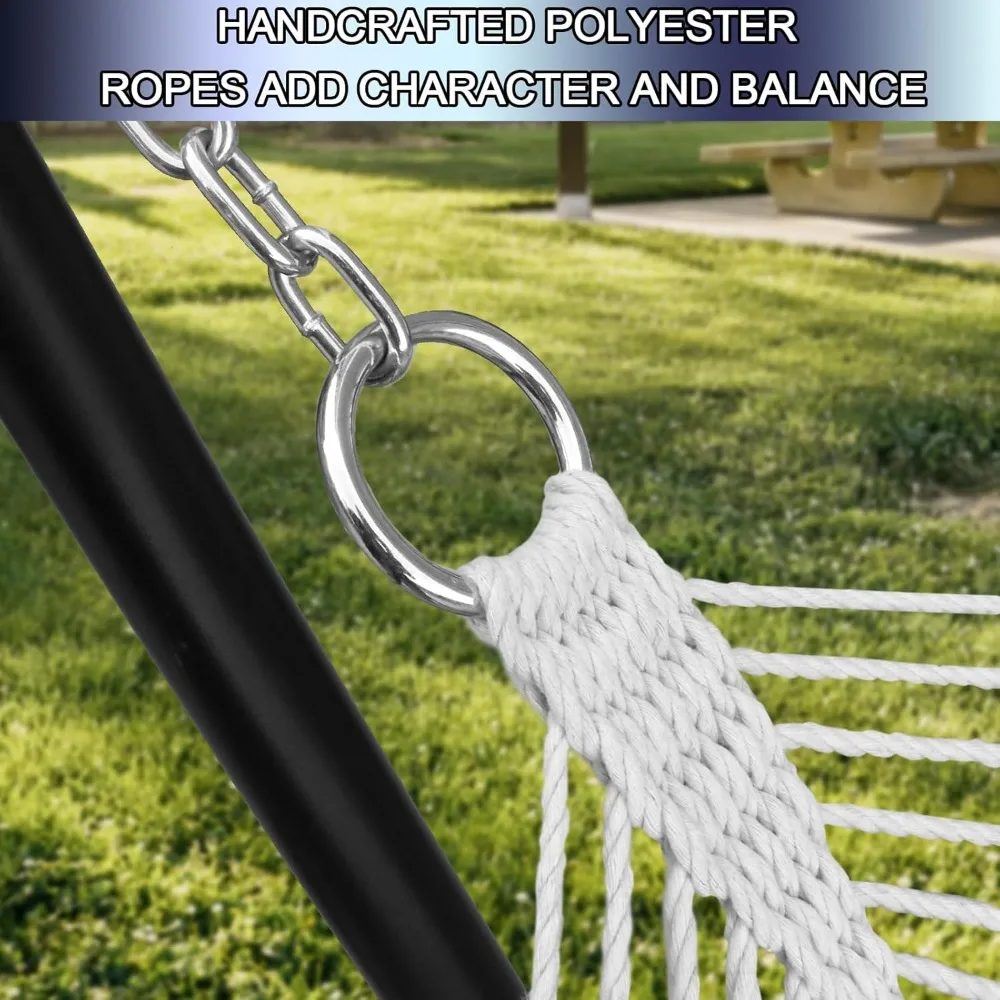
Synthetic Fabric Hammocks: Engineered for Outdoor Performance
Synthetic fabrics have revolutionized outdoor hammocks by addressing the primary weaknesses of natural materials while maintaining comfort.
Polyester Hammocks
Polyester has become the workhorse of outdoor hammock fabrics by offering excellent all-around performance:
- Exceptional UV resistance with minimal fading over time
- Good moisture resistance and relatively quick drying
- Strong resistance to mildew and mold growth
- Maintains strength even after prolonged outdoor exposure
Modern polyester hammocks typically dry within 2-3 hours of sunshine after rain, compared to potentially days for untreated cotton. Their strength-to-weight ratio also allows for hammocks that are simultaneously lightweight and durable.
Many of our most popular fabric hammock sets use high-grade polyester for its balanced performance in diverse environments.
Nylon/Parachute Fabric
Nylon excels in portable applications where lightweight strength is paramount:
- Outstanding strength-to-weight ratio
- Extremely packable with minimal bulk
- Quick-drying properties (often under an hour in sunshine)
- Smooth feel against skin
The downside? Nylon typically has less UV resistance than polyester and can degrade faster in constantly sunny environments. It’s ideal for travel hammocks but less optimal for permanent outdoor installation.
Olefin/Polypropylene
Olefin (polypropylene) offers exceptional weather resistance combined with comfort:
- Naturally water-resistant without chemical treatments
- Highly resistant to staining and fading
- Floats on water (indicating its water-repelling properties)
- Very quick-drying capabilities
These hammocks excel in pool areas, beachfront properties, and rainy climates where moisture resistance is critical.
Acrylic Fabrics (Sunbrella® and Similar)
Premium acrylic fabrics represent the highest tier of outdoor performance:
- Solution-dyed fibers that resist fading for years
- Exceptional strength and tear resistance
- Superior mold and mildew resistance
- Combines the comfort of natural fibers with synthetic durability
While more expensive than standard synthetics, solution-dyed acrylics can maintain color and integrity for 5-10 years even with regular outdoor exposure—a significant value proposition when calculating cost per year of use.
Premium Performance Fabrics: The Best of Both Worlds
Beyond basic synthetics lie specialized performance fabrics engineered specifically for outdoor furniture applications.
These advanced materials incorporate technologies developed for marine environments, outdoor sports, and commercial applications:
- Solution-dyeing – Color integrated throughout the fiber rather than surface-applied, preventing fading
- Multi-phase construction – Different fiber types combined for specific performance attributes
- Specialized coatings – Water-repellent, antimicrobial, and UV-protective treatments
- Enhanced weaving techniques – Creating stronger yet more comfortable fabric surfaces
What sets these fabrics apart is their sophisticated engineering that balances seemingly contradictory qualities: softness with durability, water resistance with breathability, and strength with flexibility. Our quilted fabric hammock sets frequently utilize these premium materials for their superior comfort and longevity.
Quilted and Padded Hammocks: Maximum Comfort Options
For those prioritizing plush comfort, quilted hammocks represent the pinnacle of luxurious relaxation.
These hammocks feature multiple fabric layers with padding sandwiched between them:
- Construction – Two layers of fabric sewn together with padding between
- Filling materials – Typically polyester batting or foam that maintains loft
- Weather considerations – Takes longer to dry due to internal padding
- Comfort level – Provides cushioning similar to a mattress or padded chair
Quilted hammocks can add 1/4” to 1” of cushioning, significantly enhancing comfort for extended lounging. They’re particularly popular for reading, afternoon naps, or creating a truly comfortable outdoor retreat. The essential features of cozy quilted hammocks include not just padding but specialized stitching that prevents filling from bunching or shifting.
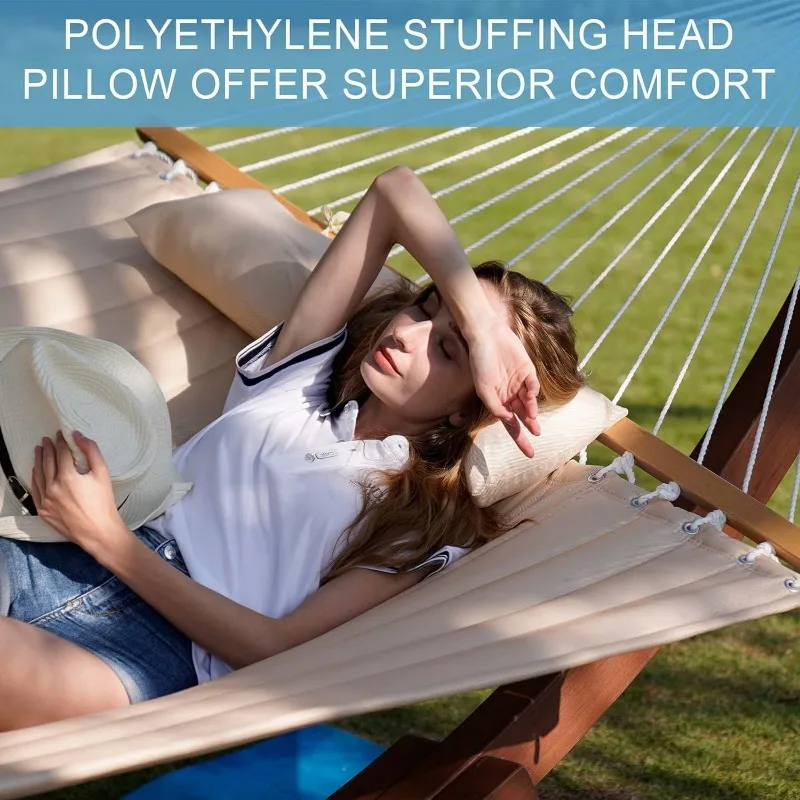
Which Fabric is Right for You? Decision Scenarios
Finding your perfect hammock fabric becomes simpler when you match materials to your specific situation and priorities.
For Hot, Sunny Environments
If you live in a climate with intense sun and high temperatures, prioritize:
* Solution-dyed acrylics or high-quality polyester for UV resistance
* Open-weave designs that promote air circulation
* Light colors that reflect rather than absorb heat
* Quick-drying properties for comfort after sweating
For Rainy, Humid Regions
Those in frequent rain or high-humidity areas should focus on:
* Olefin/polypropylene for exceptional moisture management
* Synthetics with antimicrobial treatments to prevent mold
* Avoid natural fibers unless in covered areas
* Quick-drying capabilities to prevent dampness between uses
For Family Use/High Traffic
Households with children, pets, or frequent entertaining need:
* High-denier polyester or acrylic fabrics for tear resistance
* Darker colors or patterns that hide minor stains
* Easy-clean materials that can handle regular washing
* Higher weight capacities found in our spreader bar hammock sets
For Eco-Conscious Buyers
Environmentally-minded shoppers might prefer:
* Organic cotton for all-natural composition
* Recycled polyester options that repurpose plastic waste
* Solution-dyed fabrics that eliminate water pollution from dyeing processes
* Materials with longevity to reduce replacement frequency
Beyond Fabric: Other Factors Affecting Your Hammock Experience
While fabric is crucial, other design elements significantly impact your hammock’s comfort and performance.
Construction Style
The way fabric panels are sewn together affects weight distribution and support:
* Brazilian-style (gathered end) hammocks wrap around your body
* Spreader bar designs create a flatter, more bed-like surface
* Quilted hammocks provide structured support with less conforming
Suspension Systems
How your hammock hangs influences fabric tension and comfort:
* Rope-based systems allow more natural fabric movement
* Chain systems provide more precise height adjustment
* Spring systems add gentle bounce and movement
Understanding how framed and spreader bar hammocks work with different fabrics can help you choose the optimal combination for your relaxation style.
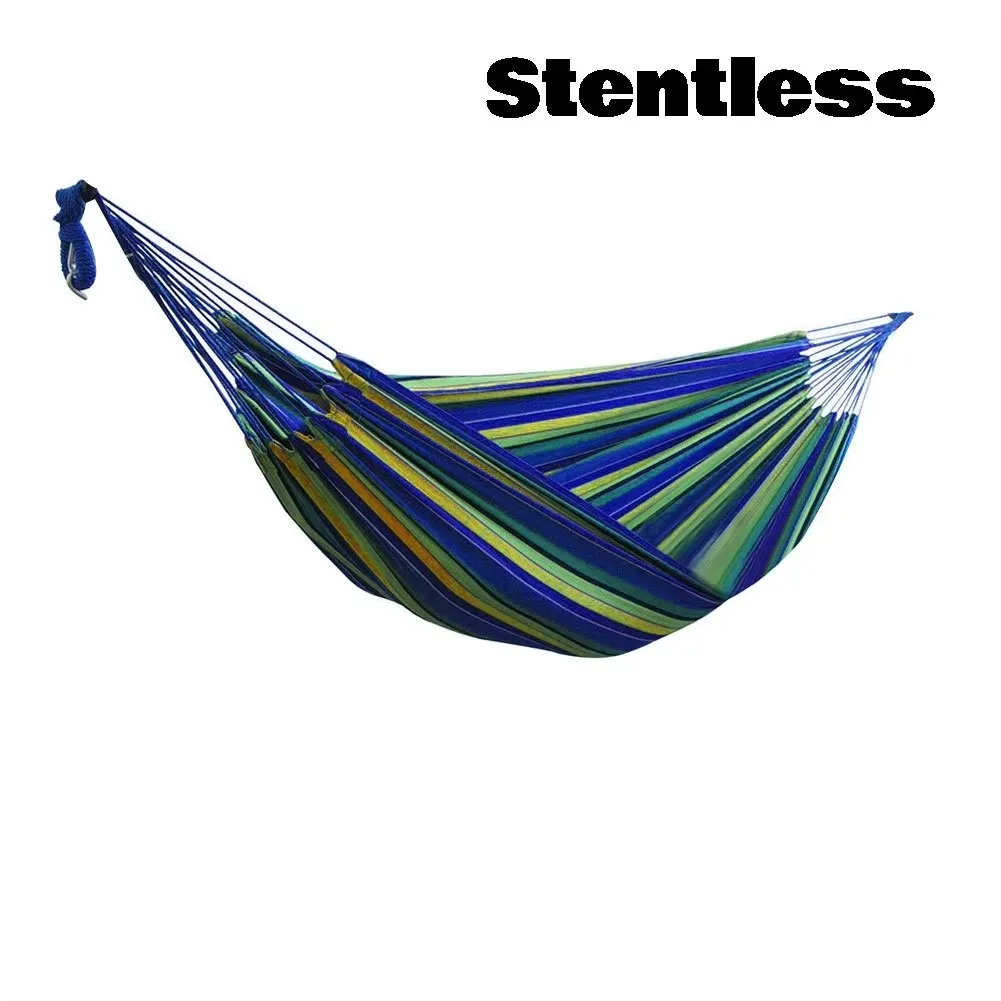
Classic Wooden Stand Hammock Sets, Heavy Duty Hammock Sets
$1,061.68 Select options This product has multiple variants. The options may be chosen on the product pageHammock Sets with Canopy, Heavy Duty Hammock Sets
$286.31 Select options This product has multiple variants. The options may be chosen on the product pageDouble / Two Person Hammock Sets, Rope Hammock Sets
Double Traditional Cotton Rope Hammock with Extension Chains – 450 lbs Capacity for Backyard & Patio$292.98 Select options This product has multiple variants. The options may be chosen on the product pageHeavy Duty Hammock Sets, Wooden Arc Stand Hammock Sets
$878.66 Select options This product has multiple variants. The options may be chosen on the product page
Fabric Care 101: Maintaining Your Hammock’s Beauty and Function
Proper maintenance dramatically extends your hammock’s lifespan, regardless of material choice.
General Care Tips for All Hammocks
- Remove debris regularly with soft brushing
- Address spills immediately to prevent staining
- Store in dry conditions when not in use for extended periods
- Follow weight capacity guidelines to prevent fabric stretching
Material-Specific Care
- Polyester/Nylon: Machine wash with mild detergent, air dry
- Cotton/Canvas: Hand wash with gentle soap, air dry completely before storage
- Acrylic/Performance Fabrics: Clean with diluted mild soap, rinse thoroughly
- Quilted Hammocks: Spot clean when possible to prevent filling saturation
Proper hammock installation and safety considerations also play a key role in fabric longevity by ensuring even weight distribution and appropriate tension.
Innovations in Hammock Fabrics: What’s on the Horizon
The world of outdoor fabrics continues to evolve with exciting developments that promise even better hammock experiences:
- Bio-based synthetics – Partially plant-derived polyesters with reduced environmental impact
- Enhanced breathability – New weaving techniques creating better air circulation without sacrificing strength
- Extended UV resistance – Next-generation stabilizers providing even longer color retention
- Antimicrobial advancements – New treatments preventing mold and mildew without harsh chemicals
These innovations continue improving the balance between comfort, durability, and sustainability in outdoor fabrics, with many already appearing in premium double two-person hammock sets designed for shared relaxation.
FAQ: Top Questions About Outdoor Fabric Hammocks
How long should a quality outdoor hammock fabric last?
With proper care, premium synthetic hammocks typically last 5-8 years with regular use, while natural fiber options may need replacement after 2-4 years depending on exposure and maintenance.
Can I leave my fabric hammock outside year-round?
While premium synthetics like solution-dyed acrylics can withstand continuous outdoor exposure, most hammocks benefit from storage during harsh weather or extended periods of non-use to maximize lifespan.
What’s the best fabric for a hammock that will be left in the rain occasionally?
Olefin/polypropylene and high-quality polyester offer the best combination of quick-drying properties and mildew resistance for hammocks that may experience occasional rainfall.
Are natural fiber hammocks worth the extra maintenance?
For users who prioritize traditional aesthetics and the distinct feel of natural materials, cotton and canvas hammocks can be worth the additional care requirements, especially in protected outdoor areas.
How do I know if my hammock fabric is fading from sun damage?
Check areas normally folded or hidden (like underneath or inside seams) and compare to exposed surfaces. Significant color differences indicate UV degradation that may be weakening the fabric beyond just appearance.

